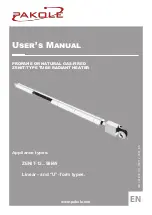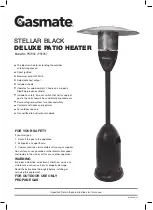
20
13.6 FITTING THE FIRE USING THE CABLE FIXING SYSTEM
-
reference should be made to the illustrations on the
next page.
a.
There is silicone sponge sealing strip already affixed to the relevant surfaces to ensure a good seal. Ensure this silicone sealing
strip stays in place during installation.
b.
A cable fixing system is supplied to secure the unit into the Fireplace Enclosure. The cable fixing system will also pull the unit
tight back against the slips to make a good seal. This is very important to ensure efficient and safe operation of the fire.
c.
There are 2 cables supplied; 1 to be used each side of the unit. Working at 730mm centres in the fireplace enclosure drill the
lower holes 20mm up from the base and drill the higher holes 610mm up from the base - see drawing on below. Secure the 4
Eyebolts supplied with the Rawlplugs to the back of the fireplace. Ensure the Eyebolts are fully screwed in and protrude no more
than 25mm.
IMPORTANT:
ENSURE THE MATERIAL THE EYEBOLT/RAWPLUG IS FIXED INTO IS SOLID AND SOUND. If the fixing is
not sound the Rawlplug/Eyebolt will be pulled out and the fire will not be sealed to the Fireplace Opening.
Note: With the minimum depth fireplace enclosure it may be necessary to sink the Eye Bolt Heads into the Brickwork.
d.
There are 2 cable attachment points on the top of the main casing; 1 each side at the rear. They are part of the folded lip of the
top section prize these up with a screwdriver to enable them to be used. Feed a cable downwards through each cable
attachment point ready for Installing the fire.
e.
Push the Flue onto the Spigots at the rear of the fire and IMPORTANT, ensure that ‘TOP’ marked on the end of the Flue
Terminal is at the top centre; using the drill provided and with the flue level mark and drill the three holes around the Spigot.
Secure the flue with the Screws provided and then seal around the flue/spigot with the Sealing Tape also provided.
IMPORTANT : Do Not Force The Flue In Too Far Or Past It’s Stop As It Will Block Off The Flow Causing Overheating.
f.
Taking care to not damage the slips, rest the Fire in the Fireplace opening so that you can still gain access to the cables and
eyebolts. Feed the cables though the eyebolts on either side and then through the hole in the back of the fire near the base
g.
Slide the Fire/Flue into the Fireplace guiding the flue into the hole until it is
part way
(leaving the fire sticking out approximately
50mm) ensuring the gas supply pipe and isolation/pressure test elbow clears through the cut out in the rear of the Main Casing
and does not foul on the control.
h.
Lift the Fire slightly and slide it home ensuring that the sealing strips on the underside of the front of the Fire and the rear of the
Fire outer frame stay in position to make a seal against the top edge of the slip at the base of the fireplace enclosure and the
front face of the slips where they locate against the rear of the Fire outer frame. While sliding the unit into the Fireplace Opening
pull on the excess cable.
i.
Referring to the illustrations on the next page feed the cables through the two loose cable clamp brackets. The adjuster and lock
screw can now be fitted onto the cable and through the large hole in the cable clamp bracket. Position the brackets one either
side of the fire towards the bottom of the channel between the Main Casing and the Inner Fire Casing. By use of the adjuster
and lock screw tighten up the cable to tension the fire back into the fireplace. The fire should be secure and not liable to
movement.
Sur plus fixing cable MUST NOT be cut off and must be tucked back through the small hole in the cable clamp bracket to keep it
well away from any electronics.
j.
If any of the silicone sealing strips are not compressed and/or if there are gaps they must be filled with a suitable sealant, fireclay
or high temperature silicone.
k.
Now on the Outside check that the End Terminal part of the Flue is clear of the hole = 130mm of Flue, the Terminal should be
clear of the wall – NOT WITHIN THE WALL.
l.
Fit, and secure the Wall Plate to the Flue through the holes provided in the flue terminal and seal to the Wall with the Stainless
Steel Screws provided.
Note: To prevent the ingress of water Sealing Foam has been supplied for the Wall Plate, if this does not provide an adequate
seal with the wall then any gaps must be filled with a waterproof silicone sealant or mastic.
Note: With the flue at the correct length and when the fire is fitted there should be 130mm of Flue Terminal Outside The Wall
and the screw holes for fixing the Wall Plate should line up with those in the Flue Terminal.
m.
Connect the isolation/pressure test elbow to the control valve and with it fully open check the joint for gas soundness.
n.
Check that all gas connections are sound. The appliance has been factory tested; however the connections may have been
disturbed in transit or storage.
! TIP !
If the Burner needs to be removed first pull both the Electronics Control Box and Infrared Sensor off their Velcro
mountings. Take out the 6 self-tapping screws securing the burner mounting plate, then taking care not to catch
the soft firebox linings and lifting at the rear, swing the whole assembly out and clear of the fire taking care not to
damage the liner panels, which are soft and can easily be marked. Take care and ensure the Receiver and
Sensor do not catch on the fire as they are removed .
! IMPORTANT NOTE !
Always reseal the pressure test point and check that it is gas tight.
(This accounts for a lot of recalls.)
















































